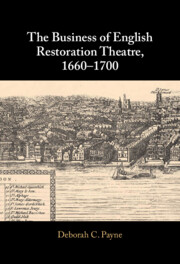Book contents
- The Business of English Restoration Theatre, 1660–1700
- The Business of English Restoration Theatre, 1660–1700
- Copyright page
- Dedication
- Epigraph
- Contents
- Figures
- Acknowledgments
- Introduction
- Chapter 1 The Theatre as Gift
- Chapter 2 The Economics of Scarcity and Prestige
- Chapter 3 The Culture of Improvement and “Great Expences”
- Chapter 4 Not Keeping Up
- Chapter 5 Fame and Famine
- Chapter 6 Stardom and Sedulousness
- Bibliography
- Index
- References
Bibliography
Published online by Cambridge University Press: 18 October 2024
- The Business of English Restoration Theatre, 1660–1700
- The Business of English Restoration Theatre, 1660–1700
- Copyright page
- Dedication
- Epigraph
- Contents
- Figures
- Acknowledgments
- Introduction
- Chapter 1 The Theatre as Gift
- Chapter 2 The Economics of Scarcity and Prestige
- Chapter 3 The Culture of Improvement and “Great Expences”
- Chapter 4 Not Keeping Up
- Chapter 5 Fame and Famine
- Chapter 6 Stardom and Sedulousness
- Bibliography
- Index
- References
- Type
- Chapter
- Information
- The Business of English Restoration Theatre, 1660–1700 , pp. 256 - 280Publisher: Cambridge University PressPrint publication year: 2024
- Creative Commons
- This content is Open Access and distributed under the terms of the Creative Commons Attribution licence CC-BY-NC 4.0 https://creativecommons.org/cclicenses/

